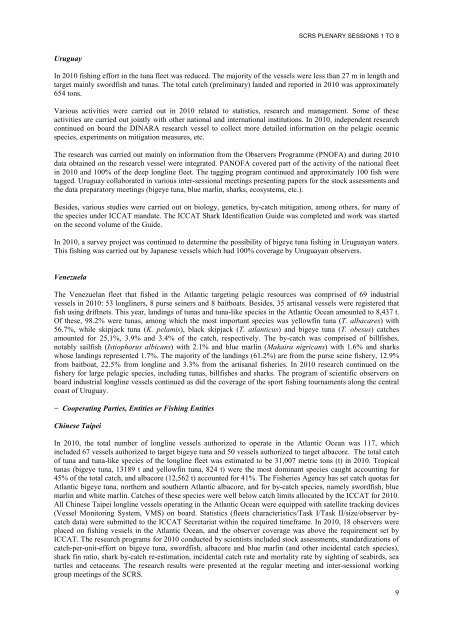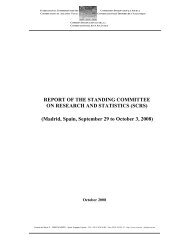You also want an ePaper? Increase the reach of your titles
YUMPU automatically turns print PDFs into web optimized ePapers that Google loves.
SCRS PLENARY SESSIONS 1 TO 8<br />
Uruguay<br />
In 2010 fishing effort in the tuna fleet was reduced. The majority of the vessels were less than 27 m in length and<br />
target mainly swordfish and tunas. The total catch (preliminary) landed and reported in 2010 was approximately<br />
654 tons.<br />
Various activities were carried out in 2010 related to statistics, research and management. Some of these<br />
activities are carried out jointly with other national and international institutions. In 2010, independent research<br />
continued on board the DINARA research vessel to collect more detailed information on the pelagic oceanic<br />
species, experiments on mitigation measures, etc.<br />
The research was carried out mainly on information from the Observers Programme (PNOFA) and during 2010<br />
data obtained on the research vessel were integrated. PANOFA covered part of the activity of the national fleet<br />
in 2010 and 100% of the deep longline fleet. The tagging program continued and approximately 100 fish were<br />
tagged. Uruguay collaborated in various inter-sessional meetings presenting papers for the stock assessments and<br />
the data preparatory meetings (bigeye tuna, blue marlin, sharks, ecosystems, etc.).<br />
Besides, various studies were carried out on biology, genetics, by-catch mitigation, among others, for many of<br />
the species under ICCAT mandate. The ICCAT Shark Identification Guide was completed and work was started<br />
on the second volume of the Guide.<br />
In 2010, a survey project was continued to determine the possibility of bigeye tuna fishing in Uruguayan waters.<br />
This fishing was carried out by Japanese vessels which had 100% coverage by Uruguayan observers.<br />
Venezuela<br />
The Venezuelan fleet that fished in the Atlantic targeting pelagic resources was comprised of 69 industrial<br />
vessels in 2010: 53 longliners, 8 purse seiners and 8 baitboats. Besides, 35 artisanal vessels were registered that<br />
fish using driftnets. This year, landings of tunas and tuna-like species in the Atlantic Ocean amounted to 8,437 t.<br />
Of these, 98.2% were tunas, among which the most important species was yellowfin tuna (T. albacares) with<br />
56.7%, while skipjack tuna (K. pelamis), black skipjack (T. atlanticus) and bigeye tuna (T. obesus) catches<br />
amounted for 25,1%, 3.9% and 3.4% of the catch, respectively. The by-catch was comprised of billfishes,<br />
notably sailfish (Istiophorus albicans) with 2.1% and blue marlin (Makaira nigricans) with 1.6% and sharks<br />
whose landings represented 1.7%. The majority of the landings (61.2%) are from the purse seine fishery, 12.9%<br />
from baitboat, 22.5% from longline and 3.3% from the artisanal fisheries. In 2010 research continued on the<br />
fishery for large pelagic species, including tunas, billfishes and sharks. The program of scientific observers on<br />
board industrial longline vessels continued as did the coverage of the sport fishing tournaments along the central<br />
coast of Uruguay.<br />
− Cooperating Parties, Entities or Fishing Entities<br />
Chinese Taipei<br />
In 2010, the total number of longline vessels authorized to operate in the Atlantic Ocean was 117, which<br />
included 67 vessels authorized to target bigeye tuna and 50 vessels authorized to target albacore. The total catch<br />
of tuna and tuna-like species of the longline fleet was estimated to be 31,007 metric tons (t) in 2010. Tropical<br />
tunas (bigeye tuna, 13189 t and yellowfin tuna, 824 t) were the most dominant species caught accounting for<br />
45% of the total catch, and albacore (12,562 t) accounted for 41%. The Fisheries Agency has set catch quotas for<br />
Atlantic bigeye tuna, northern and southern Atlantic albacore, and for by-catch species, namely swordfish, blue<br />
marlin and white marlin. Catches of these species were well below catch limits allocated by the ICCAT for 2010.<br />
All Chinese Taipei longline vessels operating in the Atlantic Ocean were equipped with satellite tracking devices<br />
(Vessel Monitoring System, VMS) on board. Statistics (fleets characteristics/Task I/Task II/size/observer bycatch<br />
data) were submitted to the ICCAT Secretariat within the required timeframe. In 2010, 18 observers were<br />
placed on fishing vessels in the Atlantic Ocean, and the observer coverage was above the requirement set by<br />
ICCAT. The research programs for 2010 conducted by scientists included stock assessments, standardizations of<br />
catch-per-unit-effort on bigeye tuna, swordfish, albacore and blue marlin (and other incidental catch species),<br />
shark fin ratio, shark by-catch re-estimation, incidental catch rate and mortality rate by sighting of seabirds, sea<br />
turtles and cetaceans. The research results were presented at the regular meeting and inter-sessional working<br />
group meetings of the SCRS.<br />
9

















